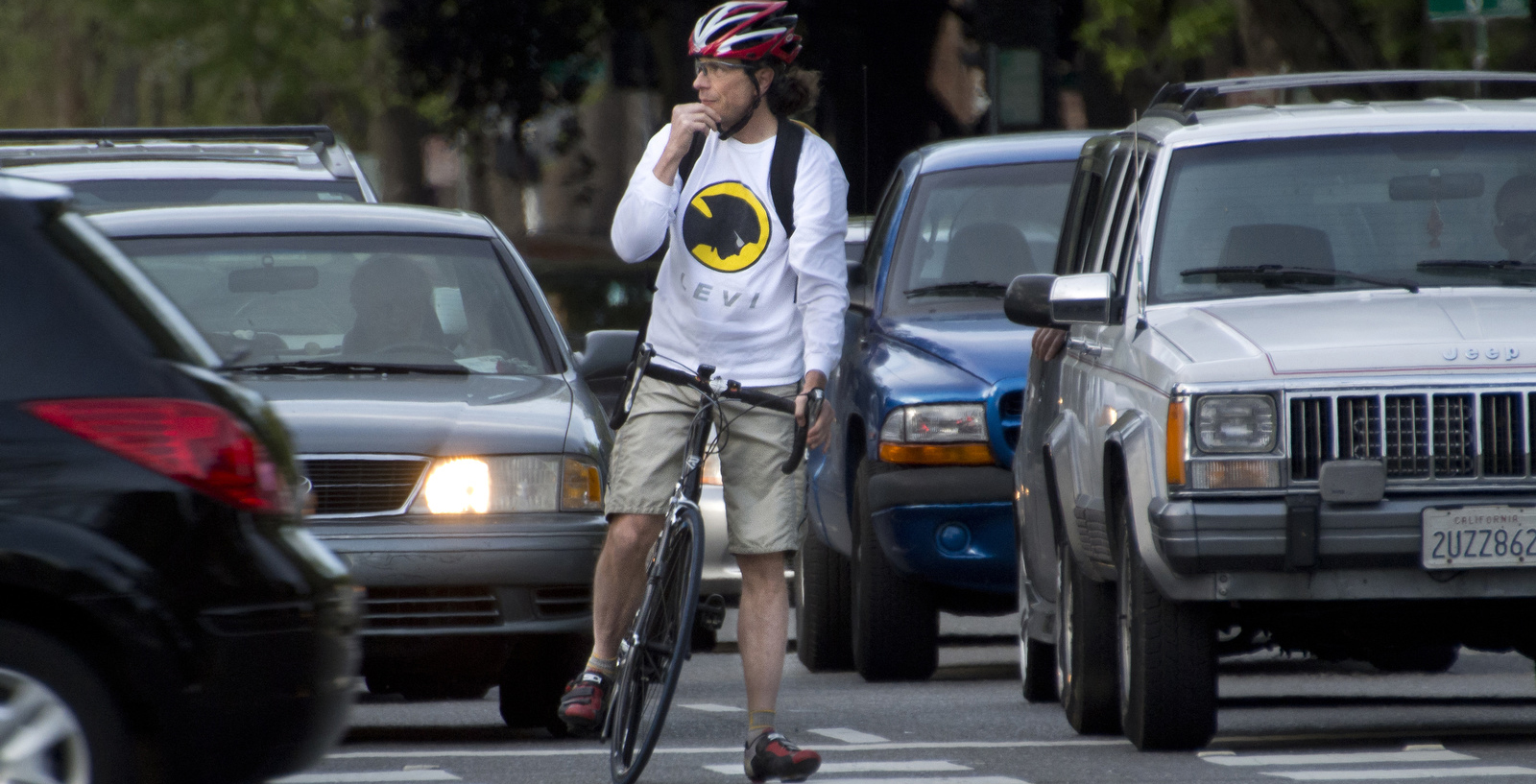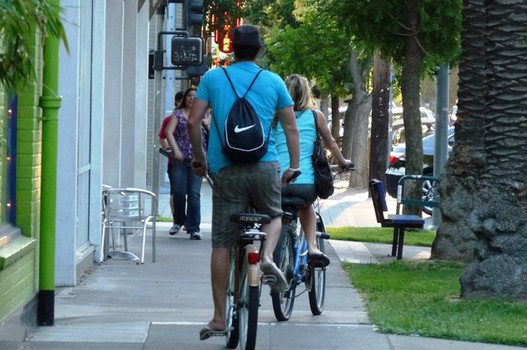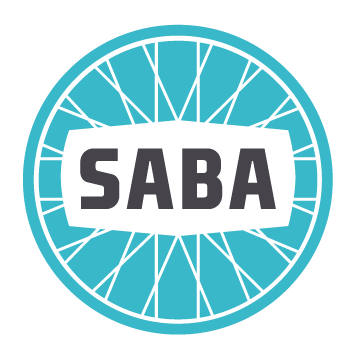Rules of the Road

California state law gives people who ride bicycles the same rights and responsibilities as motor vehicle drivers. In other words, bicycles are traffic, just like motor vehicles, and are expected to follow traffic laws and rules of the road. Where and how bikes must operate on public roads and trails are mostly contained in the California Vehicle Code (CVC 21200). Below is a summary of CVC sections related to bicycling, with links to the exact statutory language.
Note: This information is provided as a public service. It is not legal advice and should not be interpreted as such. SABA does not provide legal counsel.
Where you may ride
On streets and roads without bike lanes: Because they usually travel at slower speeds than other traffic, people on bikes must ride as close to the right side of the road as safely possible. (The same rule applies to cars and other vehicles driving slower than other traffic.)
However, people on bikes may ride in the center of the lane when they’re:
- Traveling the same speed as vehicle traffic.
- Passing (e.g., a double-parked car, another bike rider).
- Making a left turn.
- Avoiding hazards in the road (e.g., broken glass, an open car door).
- Unable to share the lane (ride side-by-side with vehicle traffic) because it’s too narrow.
- Avoiding a place where a right turn is authorized, such as at an intersection or a dedicated driveway entrance.

On a one-way street, people on bikes may ride on the left side as far to the left as safely possible, with the same exceptions described above. CVC 21202
On streets and roads with bike lanes: People riding bikes must use the bike lane. However, they can leave the bike lane and ride in the traffic lane when:
- Traveling the same speed as vehicle traffic.
- Making a left turn.
- Passing (e.g., a double-parked car, another bike rider).
- Making a left turn.
- Avoiding hazards in the road (e.g., broken glass, an open car door).
- Avoiding a place where a right turn is authorized, such as at an intersection or a dedicated driveway entrance. CVC 21208
Direction of travel: People riding bikes in the roadway or on the shoulder must travel in the same direction as motor vehicle traffic in the adjacent lane. This rule also applies to bike lanes. Unless otherwise indicated, bike riders in a bike lane must travel in the same direction as motor vehicles in the adjacent lane. CVC 21650.1
On sidewalks: Cities and counties make the rules about whether bikes may be ridden on sidewalks. CVC 21206 See below for a summary of the rules about riding on sidewalks throughout the Sacramento region.
On freeways: Bicycles may not be ridden on freeways and expressways where doing so is prohibited by Caltrans and local authorities. CVC 21960
On toll bridges: People riding bikes may not cross a toll bridge unless permitted to do so by Caltrans. CVC 23330
Motorized bicycles: Motorized bicycles (mopeds) may not be used on trails, bike paths or lanes unless allowed by local authorities. CVC 21207.5

Electric bicycles: State law defines three classes of e-bikes and specifies where and how each can be ridden. Class 1 and 2 e-bikes may be used in bike lanes and on off-street bike paths (unless specifically prohibited by a city or county). Class 3 e-bikes, the most powerful type, may only be ridden in the street and bike lanes but may not be ridden by anyone under age 16. Sacramento County Parks allows use of Class 1 and 2 e-bikes on the American River Parkway. CVC 312.5 and CVC 21213
Bike path obstruction: No one may stop on or park a bicycle on a bicycle path. Instead, park to the side of the path. CVC 21211
Equipping your bike
Bicycle size: Bicycles must be small enough for the rider to stop, support it with one foot on the ground, and start safely. CVC 21201(c)
Handlebar height: Handlebars must not be higher than the rider’s shoulders. CVC 21201(b)
Seats: All riders must have a permanent, regular seat, unless the bicycle is designed by the manufacturer to be ridden without a seat. Bicycle passengers weighing less than 40 lbs. (children) must have a seat which retains them in place and protects them from moving parts. CVC 21204
Brakes: Bicycles must be equipped with a brake that allows an operator to execute a one-braked-wheel skid on dry, level, clean pavement. CVC 21201(a)
Lights: A white headlight visible from the front must be attached to the bicycle or the bike rider at night. CVC 21201(d) and CVC 21201(e)
Reflectors: At night bicycles must have reflectors visible from the:
- Back: red reflector
- Front and back: white or yellow reflector on each pedal or on the bike rider’s shoes or ankles.
- Side:
- White or yellow reflector on the front half of the bicycle, and
- A red or white reflector on each side of the back half of the bike. These reflectors are not required if the bike has reflectorized tires. CVC 21201(d)

Operating Your Bike
Signaling: Just like drivers, people riding bikes must signal their turns:
– Left turn: Left arm and hand held out to the left side
– Right turn: Left arm and hand held pointing up OR right arm and hand held out to the right side
– Stopping or slowing down: Left arm and hand pointing down. CVC 22111
Helmets: People on bikes and their passengers under age 18 must wear an approved helmet. CVC 21212
Headphones: People riding bikes may not wear earplugs in both ears or a headset covering both ears. Hearing aids are allowed. CVC 27400
Alcohol and drugs: People on bikes may not ride while under the influence of alcohol or drugs. The ticket for riding under the influence is $250. CVC 21200.5
Hitching rides: People riding bikes may not ride while holding onto a moving vehicle. CVC 21203

Carrying objects: People on bikes may not carry objects that keep them from using at least one hand on the handlebars. CVC 21205
Pedestrians: People on bikes must yield the right-of-way to pedestrians within marked crosswalks or within unmarked crosswalks at intersections. People riding bikes must also yield the right-of-way to visually impaired pedestrians who are carrying a white cane or using a guide dog. CVC 21950 and CVC 21963
Parking: People on bikes may not leave their bikes lying on the sidewalk or parked in a way that obstructs pedestrians. CVC 21210
Riding on the Sidewalk - Is it Legal?
State law lets cities and counties decide how to regulate bike riding on sidewalks. Sidewalk riding is allowed in parts of the Sacramento region but the rules vary considerably from place to place.
If you live in an area where sidewalk riding is legal, we encourage you to do so in a safe and courteous manner. In most areas, pedestrians don’t expect to encounter bicycles being ridden on sidewalks, especially coming up from behind. In recent years, several pedestrians in Sacramento have been severely injured by people riding bikes on the sidewalk.
If you feel you must ride on the sidewalk, you can help keep pedestrians (and yourself) safe by riding slowly, carefully, and respectfully. Extra care is needed when riding near small children, animals (especially pets and companion animals on leashes), senior citizens, and people who are visually impaired or have any kind of mobility impairment. Ride at a walking pace whenever you’re near a pedestrian—getting off your bike and walking it is an even better way to help keep everyone safe.
Local rules for riding on the sidewalk:
Riding on sidewalks is not allowed in:
– Folsom
– Galt
– Davis (central business district)
Elk Grove: Bikes can be ridden on a sidewalk that has been designated as a part of the city’s bike route system. People riding on the sidewalk must yield the right-of-way to pedestrians. (Elk Grove Municipal Code 10.12.010)
Sacramento: Bikes can ride on the sidewalk unless signage is posted saying otherwise. (Sacramento Municipal Code 10.76.010)
Sacramento County (unincorporated): Bikes may be ridden on sidewalks that are designated as bike routes, but are not prohibited on any sidewalks. (Sacramento County Code 10.12.010)
West Sacramento: Bikes can be ridden on a sidewalk in the business district. People on bikes must yield the right-of-way to pedestrians. (West Sacramento Municipal Code 10.32.020)
Citrus Heights, Rancho Cordova and Yolo County do not have ordinances that allow or prohibit riding on sidewalks.






